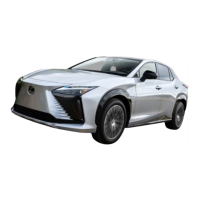304
6-2. Using the safe driving support functions
tance
Approximately 15 mph (20 km/h) or more
● Curve deceleration assistance
Approximately 15 mph (20 km/h) or more
● Steering assist within a lane
Approximately 5 to 80 mph (10 to 140
km/h)
■ System operation will be canceled when
● In the following situations, system opera-
tion will be canceled:
• When the dynamic radar cruise control
or cruise control is operating
• When the PCS is off
• Situations in which some or all of the
functions of the system cannot oper-
ate:P.275
• When the P, R or N shift position is
selected
● In the following situations, the brake
operation assist will be canceled:
• Approximately 9 mph (15 km/h) or less
• When a certain vehicle speed has been
reached, as judged by the system,
according to the surrounding conditions
● In the following situations, system opera-
tion may be canceled:
• When the brake control or output restric-
tion control of a driving support system
operates
(For example: PCS, drive-start control)
• When the system determines that a
detected object has moved away from
the vehicle
• When lane lines can no longer be
detected
• When the brake pedal has been
depressed
• When the accelerator pedal has been
depressed
• When the steering wheel has been oper-
ated with more than a certain amount of
force
• When the turn signal lever is operated to
the left/right turn position
WARNING
■ Situations in which the system may
not operate properly
● Situations in which the lane may not be
detected:
P.274
● When a detectable object stops
immediately before entering the path
of the vehicle
● When passing extremely close to a
detectable object behind a guardrail,
fence, etc.
● When changing lanes while overtaking
a detectable object
● When passing a detectable object that
is changing lanes or turning left/right
● When there are objects (guardrails,
power poles, trees, walls, fences, poles,
traffic cones, mailboxes, etc.) in the
surrounding area
● When there are patterns or a painting
ahead of the vehicle that may be mis-
taken for a detectable object
● When passing through a place with a
low structure above the road (tunnel
with a low ceiling, traffic sign, sign-
board, etc.)
● When driving on snowy, icy, or rutted
roads
● When a detectable object is
approaching your vehicle
● When your vehicle or a detectable
object is wandering
● When the movement of a detectable
object changes (change in direction,
sudden acceleration or deceleration,
etc.)
● When suddenly approaching a detect-
able object
● When a preceding vehicle or motor-
cycle is not directly in front of your
vehicle

